Malaysia Resume Formats, Templates, and Writing Tips
Applying for a job in Malaysia? This Malaysia resume guide has the templates, tips, examples, and format requirements needed to write the perfect resume.
If you’ve been applying for jobs in Malaysia as a foreign worker with no results, the problem might not be you. It could be your resume. With a busy and vibrant work culture (especially in metropolitan Kuala Lumpur), it can be difficult for a foreign worker to stand out amongst their competition – or worse, they stand out in a bad way with a resume that isn’t aligned with the standards and expectations of Malaysian hiring managers.
If you’re wondering how to optimize your resume for Malaysia, you’re in luck: we’ll go over Malaysian resume formats and provide several examples of Malaysian resumes to get your job search back on track.
The 3 Popular Malaysian Resume Formats
In most countries, you’ll find three main types of resume format mentioned. There are exceptions to this, but, thankfully, Malaysia isn’t one of them! That means when it’s time to create your resume, you’ll need to choose between those three resume formats: reverse chronological, functional, or combination.
But what exactly does that mean? What makes any of those different? And how do you know which of them is best for you and your goals?
Let’s break the 3 popular Malaysian resume formats down.
Is a Reverse Chronological Format Right for Your Malaysian Resume?
Reverse chronological resumes are the most popular and most common resume format – in Malaysia and internationally. You more than likely already have experience with this type of resume. You might even already have a reverse chronological resume ready to go!
As the name suggests, a reverse chronological resume focuses on your work experience, and details this information in reverse chronological order – meaning your most recent or current job is listed first. Hiring managers like reverse chronological resumes because they can easily understand what you’ve been doing and what results you’ve achieved at your previous roles. A reverse chronological resume is usually the best option for any Malaysian resume, because the format is somewhat universal.
Is a Functional Format Right for Your Malaysian Resume?
Where a reverse chronological resume highlights your work experience, functional resumes place focus on your skills. These resumes are often used in speciality industries where an exact skillset or certification is a requirement. Hiring managers in those industries are more open to functional resumes because they allow them to see your skills more quickly and easily, meaning they can identify whether you’d be a good fit for the job more efficiently.
While functional resumes certainly have their place in many job searches, they aren’t a typical resume format for Malaysia. Unless the job posting specifically asks for a functional resume, you’re likely better off opting for a reverse chronological resume.
Is a Combination Format Right for Your Malaysian Resume?
As the name suggests, a combination resume combines the reverse chronological and functional resume by highlighting which skills you gained at each stage of your career journey. These resumes can be useful because they explain your skills to the hiring manager, rather than simply listing them in a separate section of the resume.
How to Write a Malaysian Resume
The format for a Malaysian resume is similar to most resume formats in the Western world. If you’re from the US or Europe, for example, and you’ve already written a resume, turning your resume into a Malaysian resume should be fairly straightforward.
But what if you’ve written your Malaysian resume and you aren’t getting any responses from employers? It might not be an issue with the format of your resume, but with the content. Let’s take a look at the typical Malaysian resume sections and how to optimize your Malaysian resume for the best results.
Work Experience Format for a Malaysian Resume
In most resumes, your work experience section is the most important part of your resume: this is where you demonstrate the impact you can bring to a company, and it’s more than likely the first place a hiring manager will look when they first scan your resume. In short, if your work experience section is lacking, you’ll find it extremely difficult to make it to even an initial screening stage interview.
So how do you make sure your work experience catches a hiring manager’s eye? Generally, the key is to include metrics – especially numbers. Whenever possible, tell the hiring manager exactly how you improved each workplace you’ve had. Including things like increasing revenue or another metric by a specific percentage, for example, is an excellent way to quickly set yourself apart.
Malaysian Resume Summary Format
A resume summary should be concise and to the point. Generally speaking, you can use the following format to write your Malaysian resume summary:
- Begin with your job title or position, including years of experience you have more than 5
- Follow with a brief statement summarizing your experience, expertise, and career goals
- End with your most recent relevant achievements and skills
A summary that follow this format would look something like this:
Seasoned software engineer with over 10 years of experience designing, developing, and implementing cutting-edge software solutions. Proficient in multiple programming languages and frameworks, with a strong focus on Java, Python, and JavaScript. Extensive expertise in full-stack development, including front-end UI/UX design and back-end system architecture. Demonstrated success in leading cross-functional teams to deliver high-quality software products on time and within budget. Proven track record of solving complex technical challenges and driving innovation through continuous learning and experimentation. Excellent communication skills and ability to collaborate effectively with stakeholders to understand requirements and deliver optimal solutions.
Format to List Skills on Your Malaysian Resume
When listing your skills on your Malaysian resume, you can usually opt to simply list each relevant skill within your resume template. VisualCV’s resume templates include skill bars for each skill, so you can indicate your level of experience or proficiency with each skill.
While your skills section doesn’t need to go in-depth, it’s actually one of the most important parts of your resume – especially when it comes to ATS software. Applicant Tracking Systems look for specific keywords in resumes, filtering the best of the bunch to the next step (usually, being seen by an actual hiring manager). Carefully read each job description, looking for the exact skills (such as softwares, certifications, or other specific requirements) listed. Then, be sure each of those skills are clearly listed in your skills section!
10 Malaysian Resume Examples
Malaysian Resume Example for Data Engineering
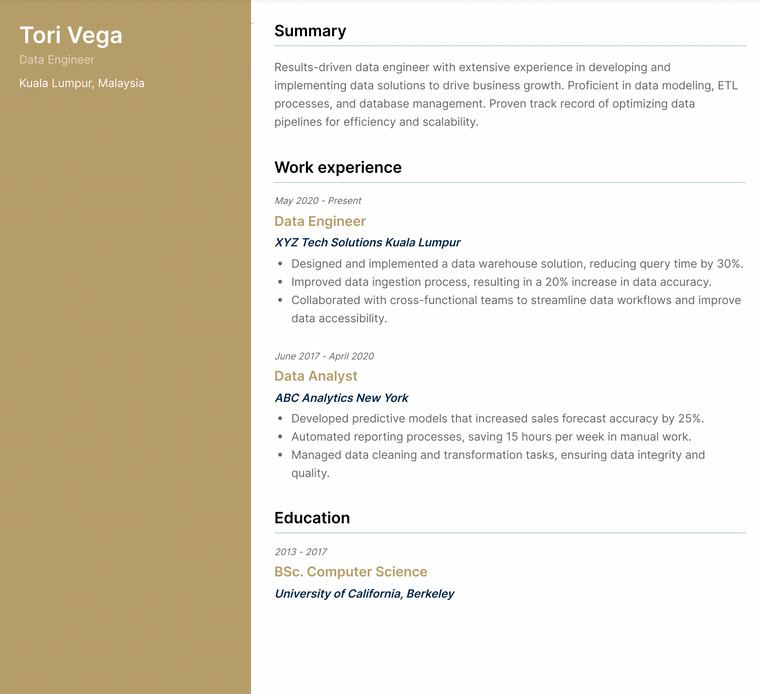
Sales Malaysian Resume Example
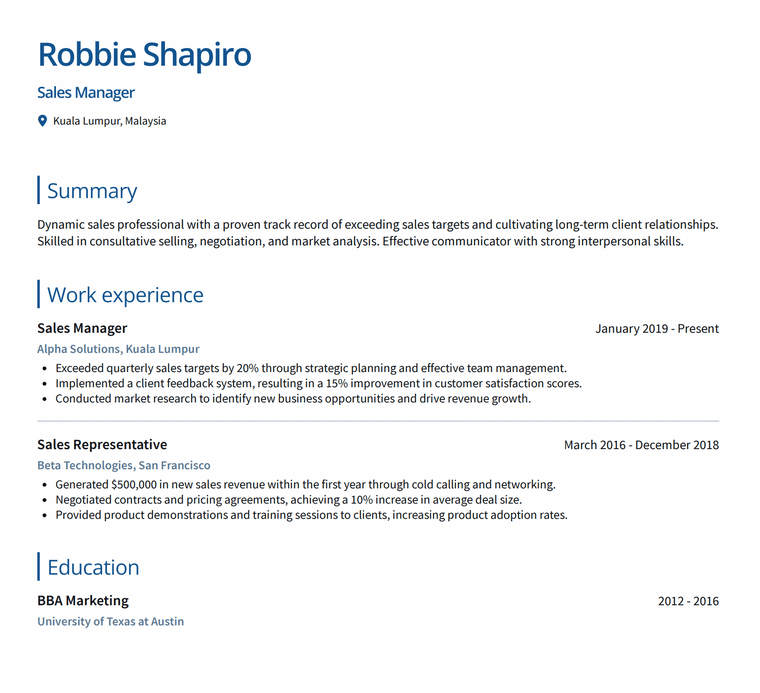
Malaysian Resume Example for Accountants
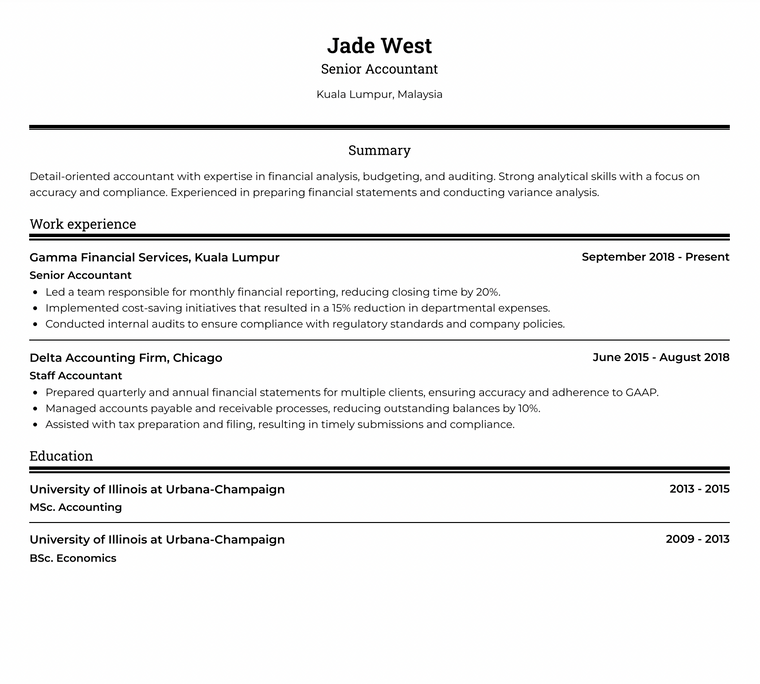
Writer Resume Example for Malaysia
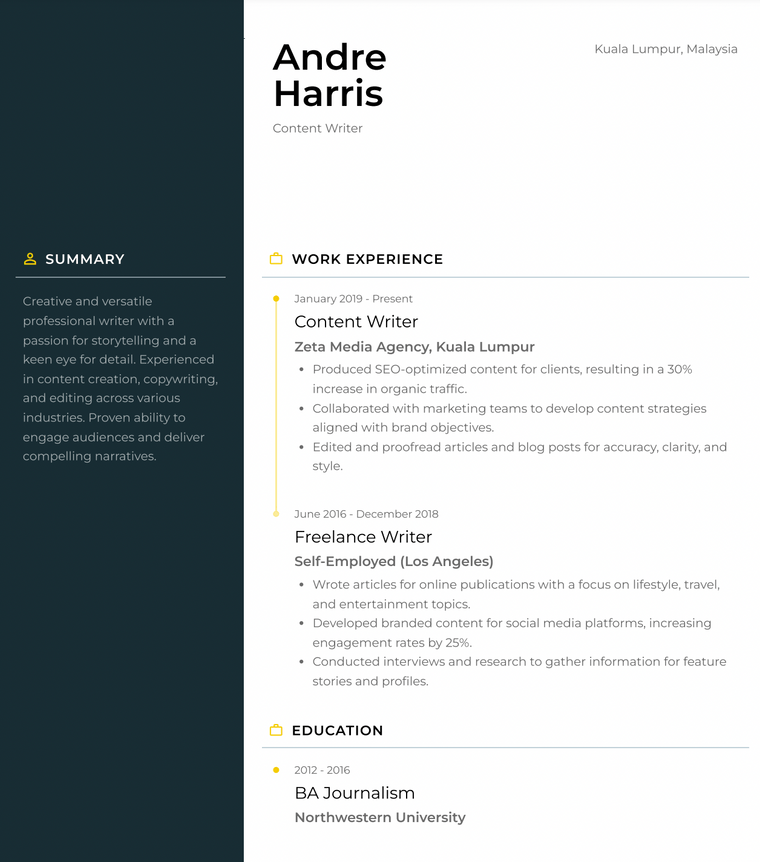
Malaysian Resume Example for Executives
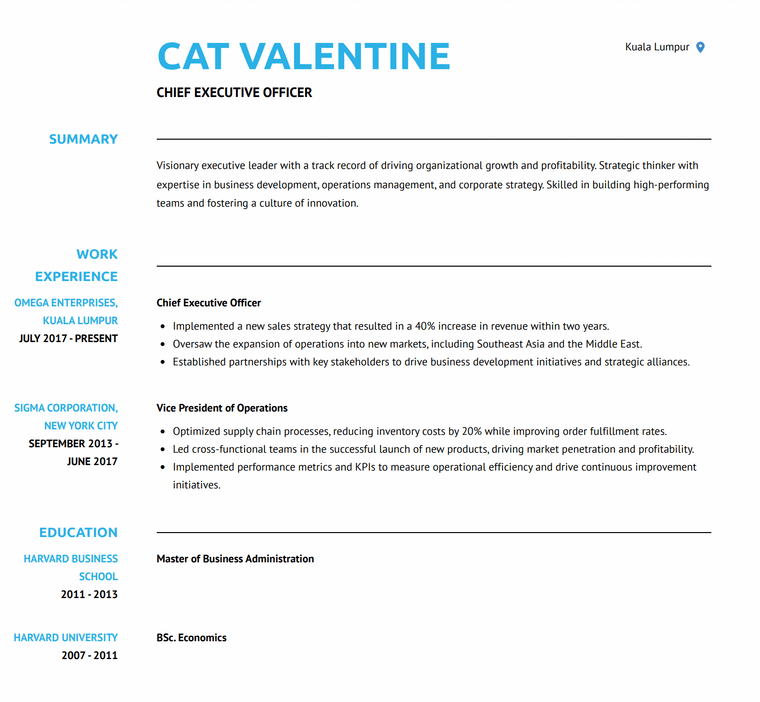
Malaysian Software Engineering Resume Example
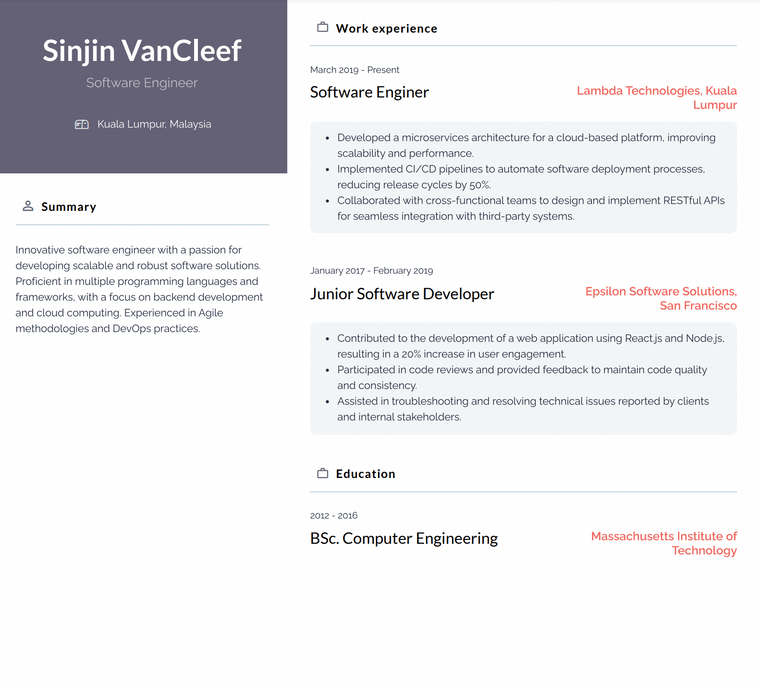
Malaysian Designer Resume Example
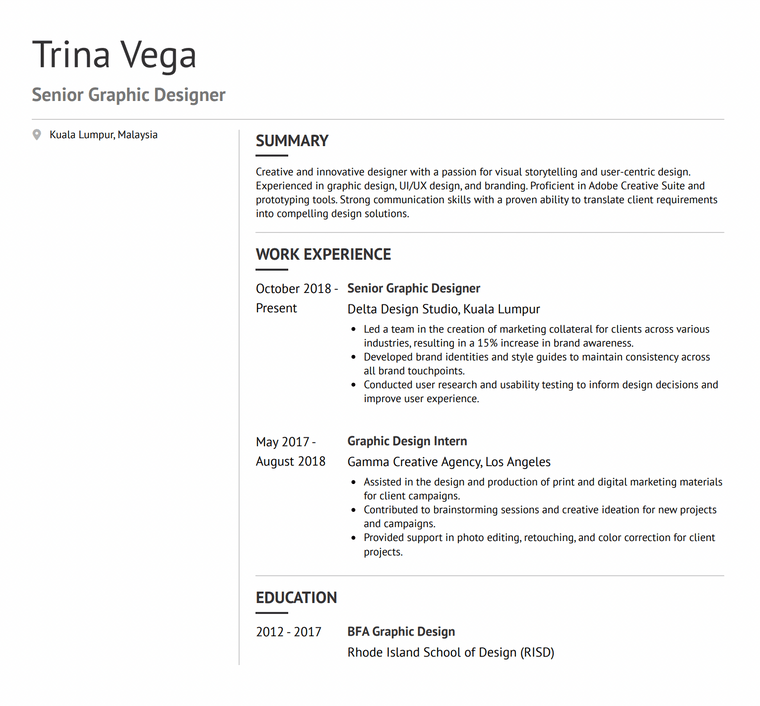
Project Management Resume for Malaysia
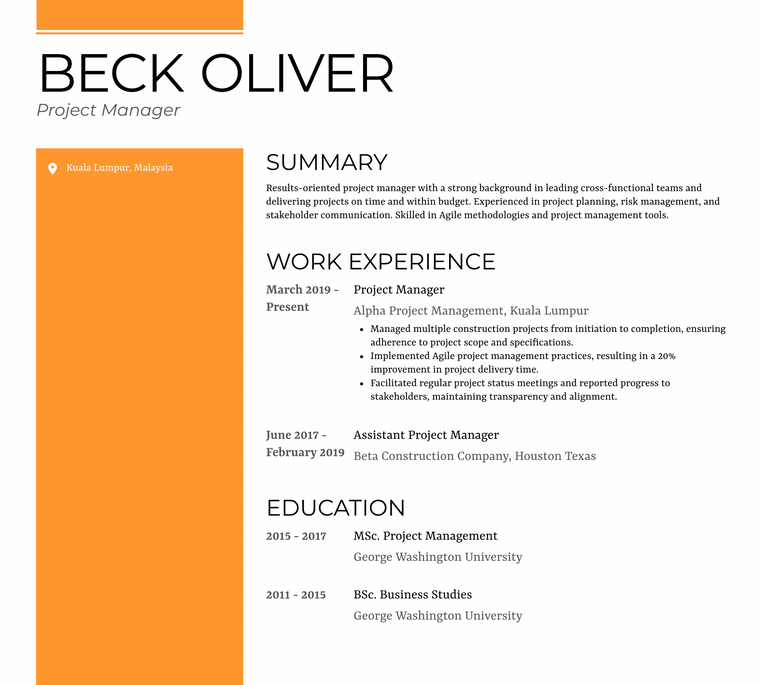
Retail Malaysian Resume Example
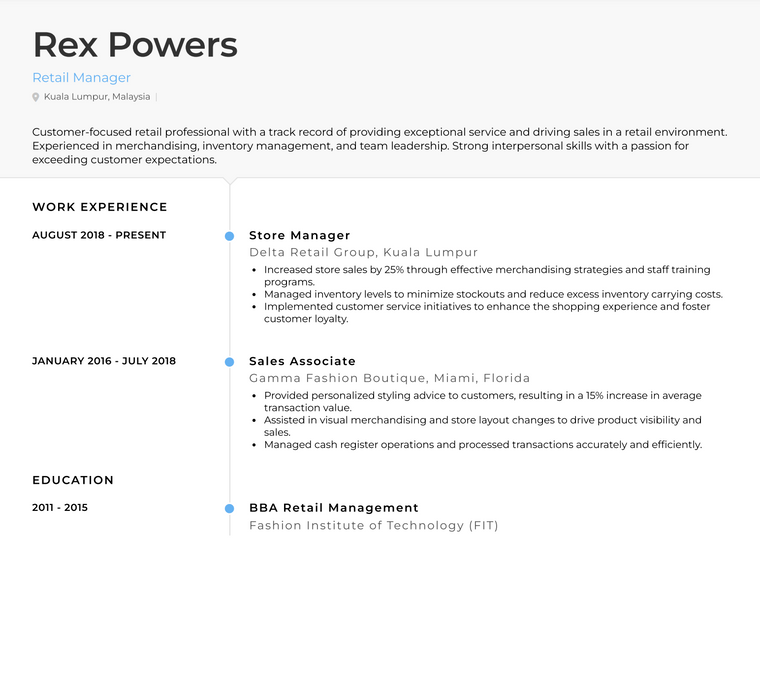
Malaysian Resume Example for Teachers
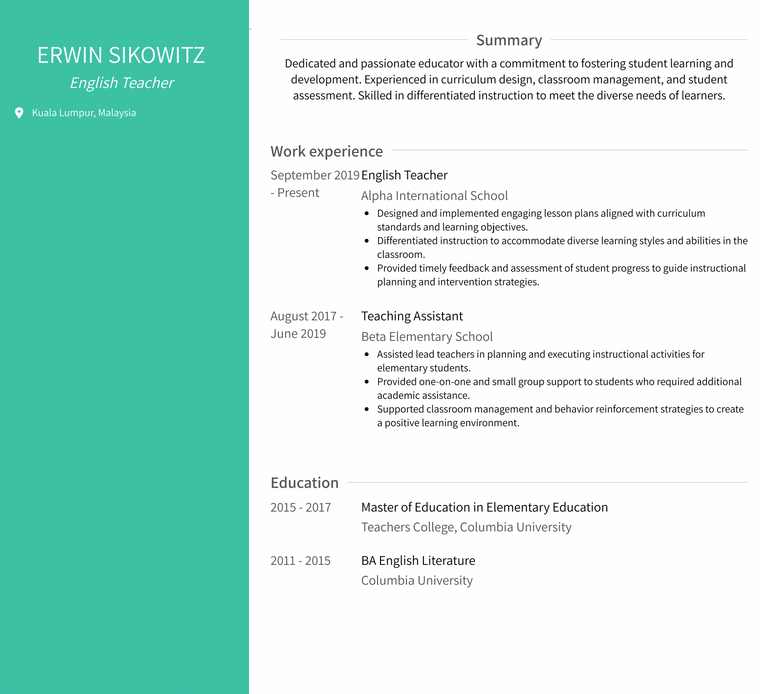
Is a Malaysian Resume Format Different from An American Resume Format?
In terms of format, an American resume is essentially the same as a Malaysian resume. The main difference is in the amount and type of information you provide in a Malaysian resume – you may be expected to include a photo of yourself, and additional personal information such as your marital status or nationality. Read each Malaysian job description carefully to understand what information they’re looking for on your resume.
How to Convert a European CV to a Malaysian Resume
The formats of a Malaysian resume and a European CV don’t differ greatly. The main difference you’ll find is that, for a Malaysian resume, you may want to include a photo of yourself, which is discouraged – or even outright banned – in many European countries.
How Long Should my Malaysian Resume be?
A Malaysian resume should be no longer than 2 pages. If you’re having trouble condensing your work history into that length, try including roles only from the last 10 years, or editing your work experience section to only include the most relevant and important information.
If you’re struggling to edit your resume into 2 pages or less, a resume review can help pinpoint weak areas and allow you to find the most important areas of your resume to highlight.
Should I Add a Photo to my Malaysian Resume?
It’s generally expected that applicants will include a photo with their resume. However, this isn’t a strict requirement – if you’re worried about including a photo, or would feel more comfortable not, then this wouldn’t necessarily stop you from landing an interview. Some employers, however, might find it unusual if you didn’t include a photo – if you’re looking to make the absolute best first impression, it’s generally a good idea to include a photo in your Malaysian resume.
Is it a Good Idea to List Marital Status on a Resume for Malaysia?
No, including your marital status on a resume for Malaysia isn’t necessary, and employers would consider it strange, outdated, or superfluous.
Should I List My Nationality on a Malaysian Resume?
If you’re applying for a job in Malaysia as a foreigner, list your nationality and visa status. This way, employers can easily gauge whether you’ll be able to work long-term and whether they need to sponsor a visa. If you’re a Malaysian citizen or resident, you won’t need to include your nationality.
Can I Lie on My Malaysian Resume?
As always, you should never lie on a Malaysian resume! Lying on a resume only ever results in disappointment for both yourself and your employer.
If you’re thinking of lying on your resume because you don’t know how to make your experience shine, a better option is to consider resume writing services. VisualCV’s professional resume writers are well-versed in Malaysian resumes and can make sure your resume stands out in all the best ways.
Copyright ©2025 Workstory Inc.